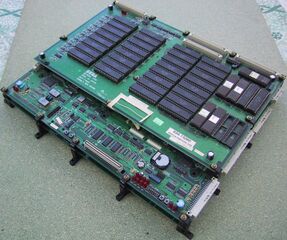Sega Model 3
From Sega Retro

| |||||
| Sega Model 3 | |||||
|---|---|---|---|---|---|
| Manufacturer: Sega, Lockheed Martin | |||||
|
The Sega Model 3 is an arcade platform produced by Sega in partnership with Lockheed Martin. It is a successor to the Sega Model 2 platform, and was released in 1996.
The Model 3 hardware is very different to the Model 1 and Model 2 boards which preceeded it. It was desinged with one purpose in mind - to push as many textured polygons as possible for as least money as possible. Upon release, the Model 3 board was more powerful than any other arcade platform on the market, as well as any home console or computer.
The Model 3 board went through a series of delays which frustrated Sega. Despite success with the previous generations of arcade harwdare, Lockheed Martin, mainly responsible for the graphics processors, were unable to finalise the specifications of the board until mid-way into 1996 - Sega had planned to release the board in late 1995 along with three games, one of which, Indy 500, was reportedly downgraded to Model 2 hardware thanks to the troubles. Scud Race and Virtua Fighter 3 debuted as the first two Model 3 games, and the board was officially supported until 1999 to make room for the Sega NAOMI and its successors.
From the early 1970s arcade had been at the forefront of graphical technology in video games, but the Model 3 hardware as well as competitors from this era stand as the last generation of arcade boards to lead the industry from a graphical perspective. PCs would begin to benefit from hardware accelerated graphics towards the end of the decade, and beginning with the Sega Dreamcast, consoles would become the basis for arcade systems, rather than the reverse as it had been up until this point. Today arcade games are built primarily around controls and the experience one gets from a game as opposed to graphics potential. Complex motion cabinets, and large, unique forms of control unsuitable for households is what drives the arcade industry in the present day.
The Model 3 went through a number of revisions (steps) in which improvements were made the system and board architecture was changed. Though there was much talk of Model 3 games being ported to the Sega Saturn, all home ports of Model 3 games were seen on the Sega Dreamcast, including the likes of Sega Rally 2, Virtua Fighter 3tb, Virtual-On Oratorio Tangram and Virtua Striker 2.
Contents
Specifications
- Main CPU: 32bits RISC PowerPC 603 66Mhz
- Graphics chip: 2 x Lockheed Martin Real3D/PRO-1000
- Sound CPU: 16bits 68EC000 11.3Mhz
- Sound chip: Yamaha SCSP/YMF-292F/"LAKE" FH1 128-step DSP x 2, MIDI interface, 16 bits 64 voices 4 channel, maximum of 16.5 Mbytes ROM, 64 PCM channels
- Audio RAM: 1meg (8 megabits, 512K per SCSP chip)
- Main memory: 8 Mbytes 66mhz Ram, graphic ROM maximum of 64 Mbytes, backup RAM 64 Kbytes
- Video resolution: 24KHz 496(H)x384(V) one or two plane
- Scroll Window: two plane (24KHz/two plane mode), 16 colors/32,768 1024 palette x 2 bank, 256/32,768 64 palette x 2 bank
- Geometrizer: 1,000,100 polygons/s for square polys, 2,000,200 for triangle polys
- Renderer: 60,000,000 pixels/s
- Video: Full color texture mapping, tri-linear interpolation, micro texture, shading high-specula gouraud shading , fix shading, flat shading, texture & edge multi layered anti-aliasing, lighting effects, parallel light, 4 spot light, pin spot light, special effect zoning-fog, 32 levels of translucency.
- Board composition: CPU + VIDEO + ROM boards
- Others: 10mbs connection, calendar IC
Hardware Images
List of Games
Step 1.0
- Boat Race GP (1996)
- Sega Bass Fishing/Get Bass (1998)
- Virtua Fighter 3 (1996)
- Virtua Fighter 3tb (1997)
Step 1.5
- Le Mans 24 (1997)
- Scud Race / Super GT (1996)
- Scud Race Plus (1997)
- The Lost World: Jurassic Park (1997)
- The Lost World: Jurassic Park Special (1997)
- Virtua Striker 2 (1997)
- Virtua Striker 2 Version '98 (1998)
Step 2.0
- Fighting Vipers 2 (1998)
- Harley Davidson & L.A. Riders (1997)
- Sega Rally 2 (1998)
- Ski Champ (1998)
- Virtua Striker 2 (1997)
- Virtua Striker 2 Version '98 (1998)
- Virtua Striker 2 Version '99 (1999)
- Virtua Striker 2 Version '99.1 (1999)
- Virtual-On Oratorio Tangram (1998)
Step 2.1
- Daytona USA 2 (1998)
- Daytona USA 2: Power Edition (1998)
- Dirt Devils (1998)
- Emergency Call Ambulance (1999)
- L.A. Machineguns (1998)
- Magical Truck Adventure (1999)
- Spike Out (1998)
- Spike Out Final Edition (1999)
- Star Wars Trilogy Arcade (1998)
- The Ocean Hunter (1998)
- Virtua Striker 2 '99 (1999)
| Sega arcade boards |
|---|
| Originating in arcades |
|
77
78
79
80
81
82
83
84
85
86
87
88
89
90
91
92
93
94
95
96
97
98
99
|
| Console-based hardware |
|
84
85
86
87
88
89
90
91
92
93
94
95
96
97
98
99
00
01
02
03
04
05
06
07
08
09
10
11
12
13
14
|
| PC-based hardware |
|
05
06
07
08
09
10
11
12
13
14
15
16
17
18
19
20
21
22
23
|



